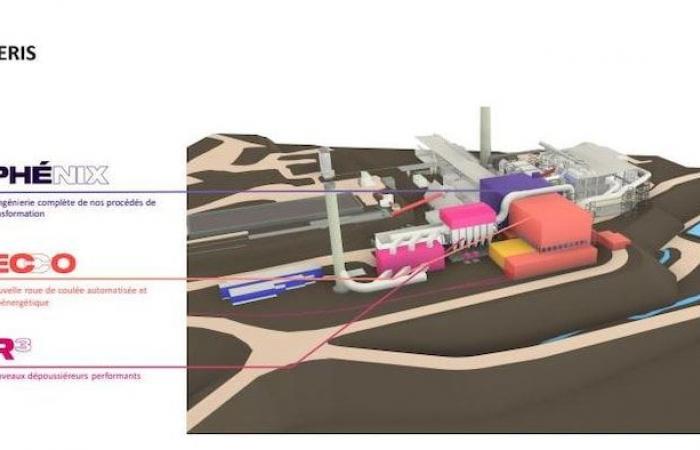The Horne Foundry’s Aeris project intended to reduce its metal emissions into the air will not come to fruition as announced. According to information obtained by -, the multinational Glencore estimates that the project, now valued at nearly a billion dollars, costs too much.
According to sources, the cost of the project, initially estimated between $500 and $750 million, was revised upwards to nearly $1 billion.
The Horne Foundry is therefore looking for solutions to reduce emissions, but at lower cost. This vast project to construct several new buildings has been canceled. The company wants to reduce its emissions from existing buildings.
Aeris is a trademark developed by the Glencore company and encompasses three modernization projects, namely Phoenix, ECCO and R3. Phénix aims to completely reconfigure transformation processes. ECCO features a new automated, energy-efficient casting wheel, while R3 involves adding new high-performance dust collectors.
Open in full screen mode
Aeris is a Horne Foundry brand that encompasses three modernization projects. (Archive photo)
Photo: Courtesy: Fonderie Horne
Under the March 2023 ministerial authorization, Glencore must reduce its arsenic emissions. This five-year authorization provides for the achievement of 15 nanograms of arsenic per cubic meter of air (ng/m3) annually by March 16, 2028. The Horne Foundry must reach 45 ng/m3 between 2024 and 2026.
Start of widget. Skip the widget?End of widget. Return to start of widget?
As of October 19, 2024, the company was close to reaching the target for the year 2024 when it emitted an average of 45.92 ng/m3 of arsenic. It must reach 45 ng/m3 air for the period from March 16, 2024 to March 15, 2025.
In the ministerial authorization of March 23, 2023, Glencore committed to implementing its entire enhanced action plan which includes the Phénix, ECCO and R3 projects. According to information obtained by -, Glencore no longer plans to carry out all of these three projects.
Glencore mentioned that the Aeris project should make it possible to reduce the average annual concentration of arsenic in ambient air to 3 ng/m3 or less for approximately 84% of the urban perimeter of Rouyn-Noranda and 15 ng/m3 at the legal station following the commissioning of the project. More than 60 people work on the Aeris project.
Open in full screen mode
The Horne Foundry factory in Rouyn-Noranda. (Archive photo)
Photo : - / Jessica Gélinas
Contacted by -, Glencore declined our interview request. By email, the company maintains that the Horne Foundry always aims to reduce its emissions. She assures that the Aeris project is still on track.
Aeris is still in a feasibility study. The pre-feasibility stage was successfully completed last April and our teams are now actively working on the feasibility, which is expected to be completed in the first quarter of 2025
writes communications and marketing advisor Marie-Maude Turcotte by email.
The certificate also provides that Glencore will have to submit a plan to achieve the provincial standard of 3 ng/m3 by the end of 2027.
A wave of layoffs
According to information obtained by -, Glencore is actively seeking solutions to reduce its expenses in its copper division in Quebec.
The multinational has made several layoffs in recent days. According to information from -, more than 50 people have lost their jobs, including several in Rouyn-Noranda. The accounting department was particularly hard hit.

Open in full screen mode
Jean-François Boulanger, researcher at UQAT. (Archive photo)
Photo: Courtesy – UQAT
The Horne Foundry is currently facing a reduction in its revenues, in particular due to competition from Chinese foundries.
What is happening is that there is not enough copper being produced by the mines. The smelters are arguing and bickering among themselves over who is going to process the little copper concentrate that is on the market.
explains Jean-François Boulanger, professor of extractive metallurgy of critical and strategic elements at the University of Quebec in Abitibi-Témiscamingue (UQAT).
As a result of this situation, the Processing Price Index, which represents the prices per tonne that are charged to mines by smelters to process copper concentrates, has fallen dramatically. While the index was around $80 per tonne a year ago in Asia-Pacific, it has fallen to such an extent that it is now in the negative.
Asia Pacific Copper Concentrate Processing Price Index
| Date | Price per ton |
|---|---|
| July 1, 2023 | 86,20 $ |
| September 1, 2023 | 88,00 $ |
| 1st November 2023 | 79,40 $ |
| January 1, 2024 | 48,20 $ |
| 1er mars 2024 | 12,70 $ |
| May 1, 2024 | – 4,00 $ |
| September 1, 2024 | – 4,00 $ |
For the last year, the index is really low. We are even talking about a negative value, which would mean in a way that Chinese smelters would practically be ready to pay to be able to continue processing copper concentrate.
adds Jean-François Boulanger, who specifies that China has become the main player in the copper market.
In the third quarter of 2024, Glencore produced 313,000 tonnes of copper anodes, which is 10% less than last year. The 338,000 tonnes of copper cathodes also represent a decrease of 10% compared to 2023.
On the Glencore website, it is specified that the situation reflects lower copper content in feed processed at the Horne Smelter and downtime at the Horne Smelters [à Rouyn-Noranda] and Pasar [aux Philippines]
.
Concentrate grades have been falling for several years because the deposits are increasingly poor, explains Jean-François Boulanger. We are exploiting increasingly lower copper contents. Obviously, the deposits with the highest copper contents were mined first.








